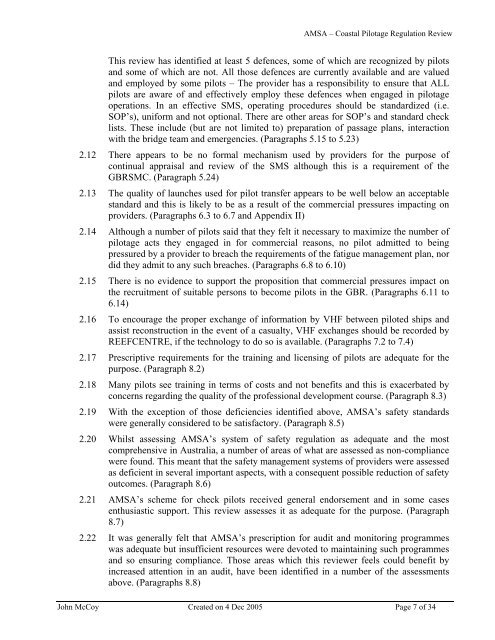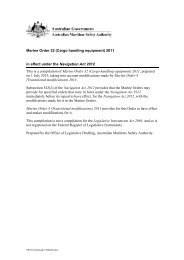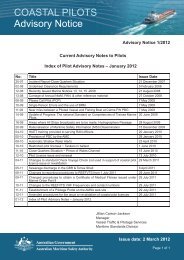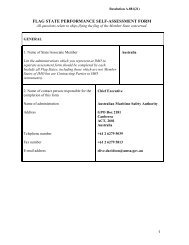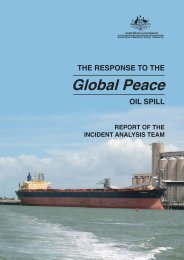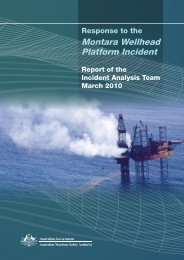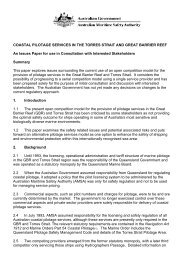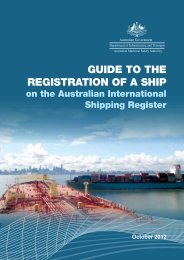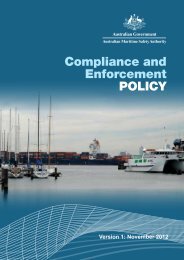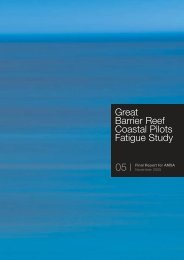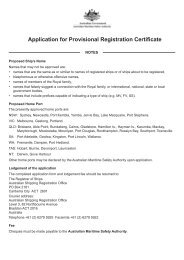Coastal pilotage regulation review - Australian Maritime Safety ...
Coastal pilotage regulation review - Australian Maritime Safety ...
Coastal pilotage regulation review - Australian Maritime Safety ...
You also want an ePaper? Increase the reach of your titles
YUMPU automatically turns print PDFs into web optimized ePapers that Google loves.
AMSA – <strong>Coastal</strong> Pilotage Regulation ReviewThis <strong>review</strong> has identified at least 5 defences, some of which are recognized by pilotsand some of which are not. All those defences are currently available and are valuedand employed by some pilots – The provider has a responsibility to ensure that ALLpilots are aware of and effectively employ these defences when engaged in <strong>pilotage</strong>operations. In an effective SMS, operating procedures should be standardized (i.e.SOP’s), uniform and not optional. There are other areas for SOP’s and standard checklists. These include (but are not limited to) preparation of passage plans, interactionwith the bridge team and emergencies. (Paragraphs 5.15 to 5.23)2.12 There appears to be no formal mechanism used by providers for the purpose ofcontinual appraisal and <strong>review</strong> of the SMS although this is a requirement of theGBRSMC. (Paragraph 5.24)2.13 The quality of launches used for pilot transfer appears to be well below an acceptablestandard and this is likely to be as a result of the commercial pressures impacting onproviders. (Paragraphs 6.3 to 6.7 and Appendix II)2.14 Although a number of pilots said that they felt it necessary to maximize the number of<strong>pilotage</strong> acts they engaged in for commercial reasons, no pilot admitted to beingpressured by a provider to breach the requirements of the fatigue management plan, nordid they admit to any such breaches. (Paragraphs 6.8 to 6.10)2.15 There is no evidence to support the proposition that commercial pressures impact onthe recruitment of suitable persons to become pilots in the GBR. (Paragraphs 6.11 to6.14)2.16 To encourage the proper exchange of information by VHF between piloted ships andassist reconstruction in the event of a casualty, VHF exchanges should be recorded byREEFCENTRE, if the technology to do so is available. (Paragraphs 7.2 to 7.4)2.17 Prescriptive requirements for the training and licensing of pilots are adequate for thepurpose. (Paragraph 8.2)2.18 Many pilots see training in terms of costs and not benefits and this is exacerbated byconcerns regarding the quality of the professional development course. (Paragraph 8.3)2.19 With the exception of those deficiencies identified above, AMSA’s safety standardswere generally considered to be satisfactory. (Paragraph 8.5)2.20 Whilst assessing AMSA’s system of safety <strong>regulation</strong> as adequate and the mostcomprehensive in Australia, a number of areas of what are assessed as non-compliancewere found. This meant that the safety management systems of providers were assessedas deficient in several important aspects, with a consequent possible reduction of safetyoutcomes. (Paragraph 8.6)2.21 AMSA’s scheme for check pilots received general endorsement and in some casesenthusiastic support. This <strong>review</strong> assesses it as adequate for the purpose. (Paragraph8.7)2.22 It was generally felt that AMSA’s prescription for audit and monitoring programmeswas adequate but insufficient resources were devoted to maintaining such programmesand so ensuring compliance. Those areas which this <strong>review</strong>er feels could benefit byincreased attention in an audit, have been identified in a number of the assessmentsabove. (Paragraphs 8.8)John McCoy Created on 4 Dec 2005 Page 7 of 34


